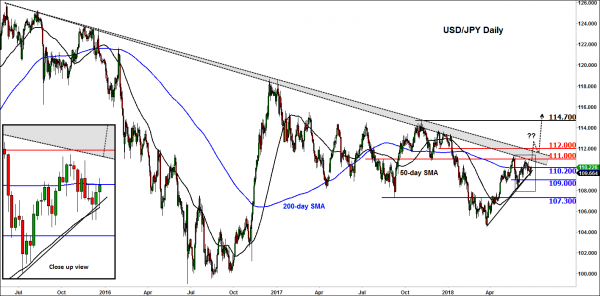Risk-sensitive assets staged a sharp relief rally after starting the day on the back foot as concerns over trade wars eased. The reversal came after news emerged that Donald Trump had softened his tone on Chinese investments and won’t invoke national emergency law on China despite reports earlier in the week suggesting he was preparing more rigorous restrictions. The Trump administration will instead use an updated version of the existing national security screening process (CFIUS) to address China’s technology theft. The news sent downbeat stocks sharply higher while in the FX markets, the USD/JPY jumped and the Chinese renminbi came off its lows after it had dropped for the tenth consecutive session against the US dollar.
Interest rate differential between Japan and US continuing to grow
While the USD/JPY may have been helped along by a relief rally today, we nonetheless expected it to rise further over time because of the growing disparity between US and Japan’s monetary policy stances.
At its most recent meeting, the Bank of Japan maintained its monetary policy unchanged and re-iterate the need to keep its stance extraordinary loose in order to help the stubbornly low Japanese inflation to climb towards the bank’s target over time. Meanwhile, the US Federal Reserve raised interest rates for the second time this year and signalled two further rate hikes in the second half of the year.
While the dollar’s response in the aftermath of the Fed’s recent policy decision has been somewhat muted with regards to the USD/JPY pair, it has managed to climb higher against other major currencies which has lifted the Dollar Index to a fresh 2018 high. The USD/JPY has been held back due to haven flows into the yen amid trade war concerns. But with concerns easing a little, and stock markets bouncing back today, there is a possibility that the USD/JPY may finally resume its rally and break decisively higher soon.
USD/JPY’s tight consolidation below key resistance points to breakout
Indeed, the USD/JPY looks technically poised for a bullish breakout after spending several weeks in a tight consolidation. As we have noted previously, it faces strong resistance around its long-term bearish trend line in the 110.00-112.00 region. If and when this resistance area is eroded only then will the bias turn decisively bullish. But while it remains below this area, the technical bias remains neutral – “neutral” as opposed to bearish because it may have formed a higher low at 105.00.


 Signal2forex.com - Best Forex robots and signals
Signal2forex.com - Best Forex robots and signals




